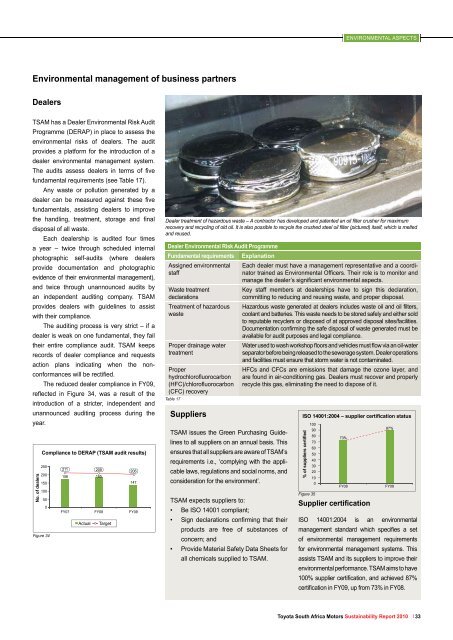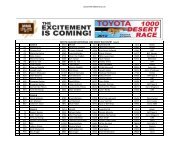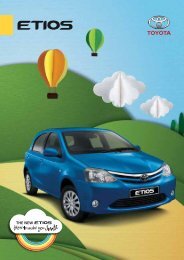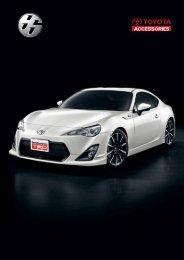to download PDF version - Toyota
to download PDF version - Toyota
to download PDF version - Toyota
You also want an ePaper? Increase the reach of your titles
YUMPU automatically turns print PDFs into web optimized ePapers that Google loves.
Environmental management of business partners<br />
Dealers<br />
TSAM has a Dealer Environmental Risk Audit<br />
Programme (DERAP) in place <strong>to</strong> assess the<br />
environmental risks of dealers. The audit<br />
provides a platform for the introduction of a<br />
dealer environmental management system.<br />
The audits assess dealers in terms of five<br />
fundamental requirements (see Table 17).<br />
Any waste or pollution generated by a<br />
dealer can be measured against these five<br />
fundamentals, assisting dealers <strong>to</strong> improve<br />
the handling, treatment, s<strong>to</strong>rage and final<br />
disposal of all waste.<br />
Each dealership is audited four times<br />
a year – twice through scheduled internal<br />
pho<strong>to</strong>graphic self-audits (where dealers<br />
provide documentation and pho<strong>to</strong>graphic<br />
evidence of their environmental management),<br />
and twice through unannounced audits by<br />
an independent auditing company. TSAM<br />
provides dealers with guidelines <strong>to</strong> assist<br />
with their compliance.<br />
The auditing process is very strict – if a<br />
dealer is weak on one fundamental, they fail<br />
their entire compliance audit. TSAM keeps<br />
records of dealer compliance and requests<br />
action plans indicating when the nonconformances<br />
will be rectified.<br />
The reduced dealer compliance in FY09,<br />
reflected in Figure 34, was a result of the<br />
introduction of a stricter, independent and<br />
unannounced auditing process during the<br />
year.<br />
No. of dealers<br />
250<br />
200<br />
150<br />
100<br />
50<br />
0<br />
Figure 34<br />
Compliance <strong>to</strong> DERAP (TSAM audit results)<br />
211 209 206<br />
156 165<br />
FY07 FY08 FY09<br />
Actual Target<br />
147<br />
ENVIRONMENTAL ASPECTS<br />
Dealer treatment of hazardous waste – A contrac<strong>to</strong>r has developed and patented an oil fi lter crusher for maximum<br />
recovery and recycling of old oil. It is also possible <strong>to</strong> recycle the crushed steel oil fi lter (pictured) itself, which is melted<br />
and reused.<br />
Dealer Environmental Risk Audit Programme<br />
Fundamental requirements Explanation<br />
Assigned environmental Each dealer must have a management representative and a coordi-<br />
staff<br />
na<strong>to</strong>r trained as Environmental Officers. Their role is <strong>to</strong> moni<strong>to</strong>r and<br />
manage the dealer’s significant environmental aspects.<br />
Waste treatment<br />
Key staff members at dealerships have <strong>to</strong> sign this declaration,<br />
declarations<br />
committing <strong>to</strong> reducing and reusing waste, and proper disposal.<br />
Treatment of hazardous Hazardous waste generated at dealers includes waste oil and oil filters,<br />
waste<br />
coolant and batteries. This waste needs <strong>to</strong> be s<strong>to</strong>red safely and either sold<br />
<strong>to</strong> reputable recyclers or disposed of at approved disposal sites/facilities.<br />
Documentation confirming the safe disposal of waste generated must be<br />
available for audit purposes and legal compliance.<br />
Proper drainage water Water used <strong>to</strong> wash workshop floors and vehicles must flow via an oil-water<br />
treatment<br />
separa<strong>to</strong>r before being released <strong>to</strong> the sewerage system. Dealer operations<br />
and facilities must ensure that s<strong>to</strong>rm water is not contaminated.<br />
Proper<br />
HFCs and CFCs are emissions that damage the ozone layer, and<br />
hydrochlorofluorocarbon are found in air-conditioning gas. Dealers must recover and properly<br />
(HFC)/chlorofluorocarbon<br />
(CFC) recovery<br />
recycle this gas, eliminating the need <strong>to</strong> dispose of it.<br />
Table 17<br />
Suppliers<br />
TSAM issues the Green Purchasing Guidelines<br />
<strong>to</strong> all suppliers on an annual basis. This<br />
ensures that all suppliers are aware of TSAM’s<br />
requirements i.e., ‘complying with the applicable<br />
laws, regulations and social norms, and<br />
consideration for the environment’.<br />
TSAM expects suppliers <strong>to</strong>:<br />
• Be ISO 14001 compliant;<br />
• Sign declarations confirming that their<br />
products are free of substances of<br />
concern; and<br />
• Provide Material Safety Data Sheets for<br />
all chemicals supplied <strong>to</strong> TSAM.<br />
ISO 14001:2004 – supplier certifi cation status<br />
% of suppliers certifi ed<br />
100<br />
90<br />
80<br />
70<br />
60<br />
50<br />
40<br />
30<br />
20<br />
10<br />
0<br />
Figure 35<br />
73%<br />
FY08 FY09<br />
Supplier certifi cation<br />
ISO 14001:2004 is an environmental<br />
management standard which specifies a set<br />
of environmental management requirements<br />
for environmental management systems. This<br />
assists TSAM and its suppliers <strong>to</strong> improve their<br />
environmental performance. TSAM aims <strong>to</strong> have<br />
100% supplier certification, and achieved 87%<br />
certification in FY09, up from 73% in FY08.<br />
<strong>Toyota</strong> South Africa Mo<strong>to</strong>rs Sustainability Report 2010 33<br />
87%





